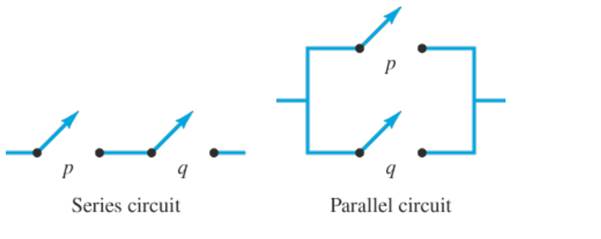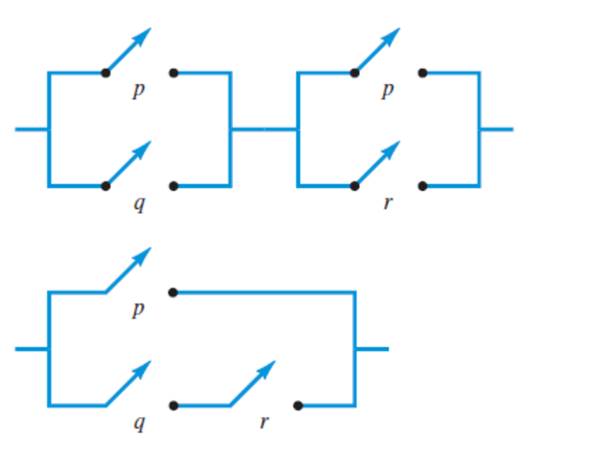
Concept explainers
In Section 3.1 (page 94), we showed how to represent computer circuits with logical expressions. We represented a series by the expression

The logical form

In Exercise 65-68, represent each circuit by a logical form and then rewrite that logical form in an equivalent form. Use truth tables to prove that the second form is equivalent to the first. Draw a circuit that corresponds to the second logical form. If possible, try to choose the second form so that the corresponding circuit has fewer switches than the original circuit.

Want to see the full answer?
Check out a sample textbook solution
Chapter 3 Solutions
MYLAB W/ETEXT FOR MATHEMATICS ALL AROUN
Additional Math Textbook Solutions
Pathways To Math Literacy (looseleaf)
APPLIED STAT.IN BUS.+ECONOMICS
Probability And Statistical Inference (10th Edition)
Calculus: Early Transcendentals (2nd Edition)
College Algebra (7th Edition)
Finite Mathematics for Business, Economics, Life Sciences and Social Sciences
- Prove that the Abomian Method (ABM) and homotopy Method (HPM) are equivalent for solving nonlinear dis Serential equations. What the relationship between AdoMian (ADM) and Dafter Dar Jafari Method.arrow_forwardWhat is the relationship between AdoMian decompoition method and homotopy Perturaba tion method with prove?arrow_forwardQuestion 3 [10 marks]. Suppose that X, Y and Z are statistically independent random variables, each of them with a x²(2) distribution. (a) Find the moment generating function of U = X + 3Y + Z. State clearly and justify all steps taken. (b) Calculate the expectation E(U) using the moment generating function.arrow_forward
- Please could you explain why 0.5 was added to each upper limpit of the intervals.Thanksarrow_forwardOpen Middle Problem #1: You can only use the digits 1 through 9 one time each in the seven boxes below. How can you arrange the digits to make the fraction multiplication problem true? 8.8.08 =arrow_forward21/solve the following differential equation Using laplace transform y₁ =-y, Y₁(0)=1 y' = Y Y₂(0)=0 2 21 Solve the following equations: dy 1- dt + 2y + = ydt 2 cost, y(0) = 1 2 2- y(t) = ±² + (yet) sin (t-u) du Q3: Answer the following: 1- L [Log Sa] (5²+9²) 2- L1 [Log (Cos²y1] 0-25 3-L-1 [ -] 4- (5+1) 3 L (ezt sin3t) e-s 5- L-1 ( 너 (0) 5² +5arrow_forward
- LESSON MATHEMATICS ACTIVITIES 1.3 DECIMALS 1. Josh used itres of ster during an Integrahed Express the ami remained DATE b) 14.07 2. Express 0.5 as a fraction in its simplest form or e) 327.034 7. Write the number form is e) 5.11x 10 ese standard 3. Express 0.145 os simplest form fraction in its b) 2.03x102 4. In August 2022, the cost of a litre of petrol was Sh 159.25. How much did kipchoge pay for two litres? c) 6.3x103 5. A doctor prescribed 12.5 ml of a dr to a patient. Express the drug prescribed in litres to two significant figures 8. Work out: a) 2.05 5.2-1.8 rite each of the following in stand- ds form 0039 b)3.6 2.8 (2.8+0arrow_forwardRK 119 43 Previous Problem University at Buffalo Problem List Next Problem Match the surfaces (a) - (f) below with the contour diagrams (1) - (6) below those. (a) Surface (a) matches contour 5 V V (b) Surface (b) matches contour 2 V (c) Surface (c) matches contour 1 (d) Surface (d) matches contour 6 V (e) Surface (e) matches contour 4 V (f) Surface (f) matches contour 3 V (4) (1) -0.25 (a) (b) (c) (d) (e) y y 2.5 0.5 1.5 1.5 1.5 y .3 0.25 OC 0.25 -0.25 (2) X 1.5 ZI (f) y 0.01 0.01 (3) ☑ X 0.01 0.01 0.2 0.2 (5) 0 x 0.5 (6) 0.25 X X 0.25 0.5arrow_forward43 University at Buffalo Previous Problem Problem List Next Problem At least one of the answers above is NOT correct. The figure shows a hill with two paths, A and B. (a) What is the elevation change along each path? 400 9400 ✓ feet (b) Which path ascends more rapidly? A v (c) On which path will you probably have a better view of the surrounding countryside (assuming that trees do not block your view)? A V (d) Along which path is there more likely to be a stream? A V Note: You can earn 50% partial credit for 2-3 correct answers. Preview My Answers Submit Answers Q hulu )))) 9800' A 10000 (Click on graph to enlarge) L ^ B 0 Logged in as Luella Ya 4)arrow_forward

 Linear Algebra: A Modern IntroductionAlgebraISBN:9781285463247Author:David PoolePublisher:Cengage Learning
Linear Algebra: A Modern IntroductionAlgebraISBN:9781285463247Author:David PoolePublisher:Cengage Learning Algebra: Structure And Method, Book 1AlgebraISBN:9780395977224Author:Richard G. Brown, Mary P. Dolciani, Robert H. Sorgenfrey, William L. ColePublisher:McDougal Littell
Algebra: Structure And Method, Book 1AlgebraISBN:9780395977224Author:Richard G. Brown, Mary P. Dolciani, Robert H. Sorgenfrey, William L. ColePublisher:McDougal Littell- Algebra & Trigonometry with Analytic GeometryAlgebraISBN:9781133382119Author:SwokowskiPublisher:Cengage
 College Algebra (MindTap Course List)AlgebraISBN:9781305652231Author:R. David Gustafson, Jeff HughesPublisher:Cengage Learning
College Algebra (MindTap Course List)AlgebraISBN:9781305652231Author:R. David Gustafson, Jeff HughesPublisher:Cengage Learning Elementary Geometry For College Students, 7eGeometryISBN:9781337614085Author:Alexander, Daniel C.; Koeberlein, Geralyn M.Publisher:Cengage,
Elementary Geometry For College Students, 7eGeometryISBN:9781337614085Author:Alexander, Daniel C.; Koeberlein, Geralyn M.Publisher:Cengage,





